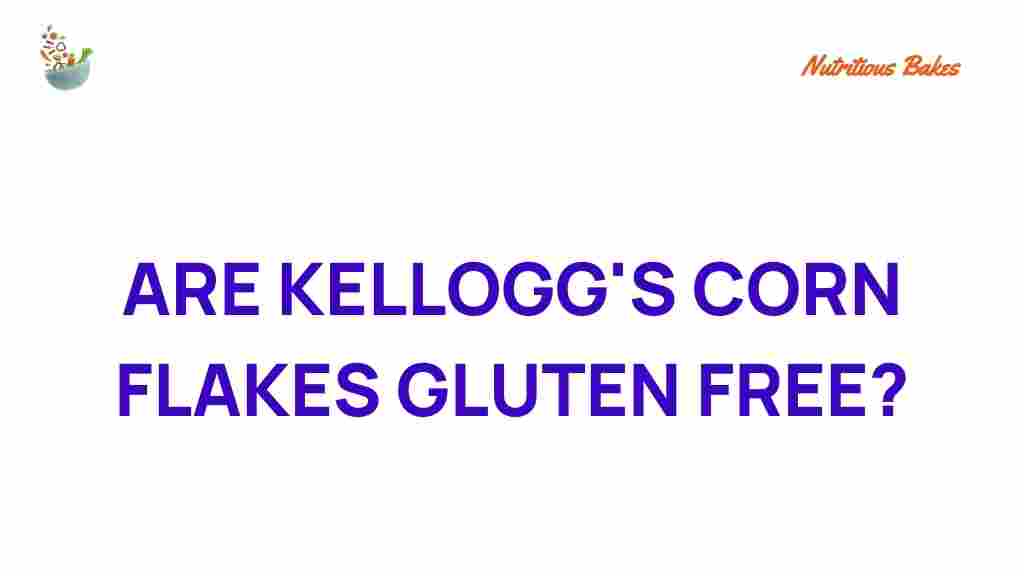Are Kellogg’s Corn Flakes Truly Gluten-Free?
When it comes to breakfast cereals, Kellogg’s Corn Flakes have long been a staple in many households. But for those with gluten sensitivities or celiac disease, the question remains: are Kellogg’s Corn Flakes truly gluten-free? In this article, we will unravel the mystery surrounding Kellogg’s Corn Flakes, focusing on their ingredients, health implications, and the overall consumer awareness regarding gluten-free products.
Understanding Gluten and Its Impact on Health
Gluten is a protein found in wheat, barley, and rye, which can trigger adverse reactions in individuals with gluten-related disorders. These include:
- Celiac disease
- Non-celiac gluten sensitivity
- Wheat allergy
For those affected, consuming gluten can lead to symptoms such as:
- Digestive issues
- Fatigue
- Joint pain
- Skin rashes
Because of these potential health risks, the demand for gluten-free products has surged, leading consumers to scrutinize food labeling more carefully.
Kellogg’s Corn Flakes: Ingredients and Food Labeling
Kellogg’s Corn Flakes are primarily made from corn, sugar, malt flavoring, and vitamins and minerals. The key ingredients are:
- Corn
- Sugar
- Malt flavoring (from barley)
- Vitamins and minerals
While corn itself is gluten-free, the inclusion of malt flavoring (derived from barley) raises concerns. Barley contains gluten, which poses a risk for those who are sensitive. Therefore, it is crucial to examine the labeling on the box.
Examining the Gluten-Free Label
In the United States, the FDA has strict guidelines for gluten-free labeling. A product can be labeled as gluten-free if it contains less than 20 parts per million (ppm) of gluten. However, this doesn’t necessarily mean that all consumers will react well to these products, especially those with severe gluten intolerance.
Consumer Awareness and Dietary Choices
With the growing awareness of gluten sensitivity, consumers are becoming more educated about their dietary choices. Many people now read labels closely and seek out products that are certified gluten-free. It’s essential for consumers to be aware of:
- Ingredient lists
- Cross-contamination risks
- Certifications and seals on packaging
For those considering Kellogg’s Corn Flakes, it is advisable to look for the gluten-free certification on the packaging. If it is not present, individuals with gluten sensitivities should approach with caution.
Step-by-Step Process to Determine if Kellogg’s Corn Flakes Are Right for You
Here’s a simple guide to help you determine whether Kellogg’s Corn Flakes fit into your gluten-free diet:
- Check the Ingredients: Look for any mention of barley or malt flavoring.
- Look for Certifications: Verify if the packaging has a gluten-free label.
- Consult with a Medical Professional: Discuss your dietary choices with a healthcare provider, especially if you have a diagnosed gluten sensitivity.
- Consider Alternatives: If unsure, explore other gluten-free cereals available on the market.
Troubleshooting Tips for Gluten-Free Diets
If you’re navigating a gluten-free lifestyle, here are some helpful tips:
- Educate Yourself: Learn about gluten-containing foods and hidden sources of gluten.
- Keep a Food Diary: Track what you eat and any reactions you experience.
- Join Support Groups: Connect with others who have gluten sensitivities for shared experiences and advice.
- Stay Informed: Follow reputable websites and resources dedicated to gluten-free living.
Nutrition Insights on Kellogg’s Corn Flakes
Kellogg’s Corn Flakes are often marketed as a healthy breakfast option. Here’s a closer look at their nutritional profile:
- Calories: Approximately 100 calories per serving (1 cup).
- Carbohydrates: About 24 grams, primarily from corn.
- Sugars: Around 2 grams, which is relatively low.
- Fiber: Less than 1 gram, making it low in fiber content.
- Vitamins and Minerals: Fortified with essential nutrients like iron and B vitamins.
While Kellogg’s Corn Flakes are low in sugar and calories, their low fiber content may not make them the best choice for everyone, especially those looking for a more balanced breakfast. Pairing them with fruits, nuts, or yogurt can enhance their nutritional value.
Conclusion: Making Informed Dietary Choices
In conclusion, the question of whether Kellogg’s Corn Flakes are truly gluten-free is nuanced. While the primary ingredient, corn, is gluten-free, the presence of malt flavoring derived from barley introduces a risk for those with gluten sensitivities. It is essential for consumers to be diligent in reading labels, seeking gluten-free certifications, and consulting with healthcare professionals regarding their dietary choices.
Ultimately, Kellogg’s Corn Flakes can be enjoyed by many, but those who are gluten-sensitive should proceed with caution. As consumer awareness grows, so does the demand for clear labeling and safe food options. For further information on gluten-free living, consider visiting reputable sources or support networks.
For more insights on gluten-free products, check out our article on Navigating Gluten-Free Foods.
This article is in the category Ingredients and created by NutritiousBakes Team
